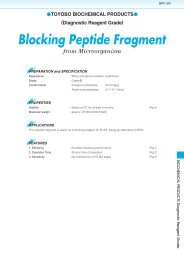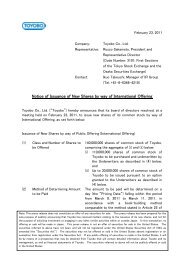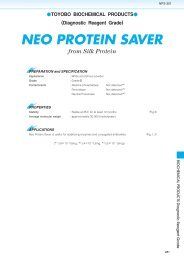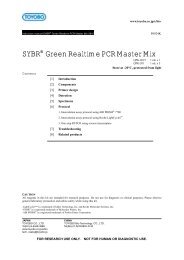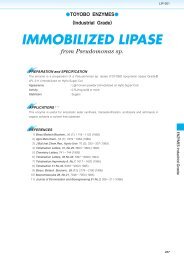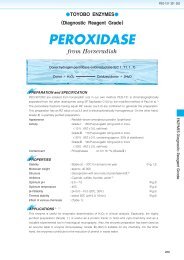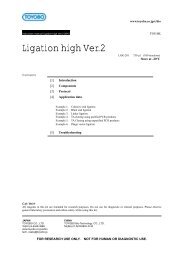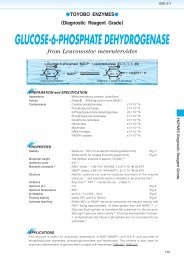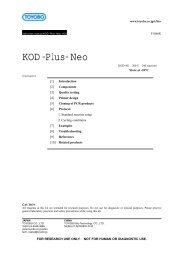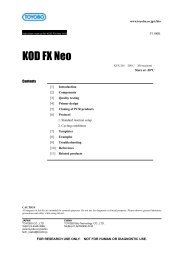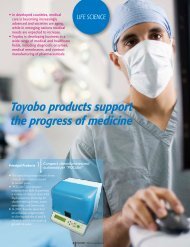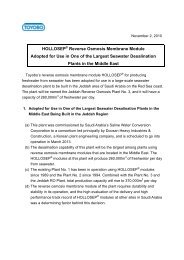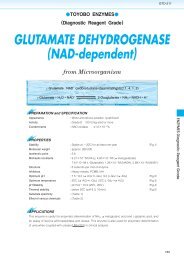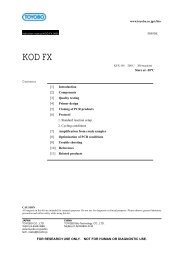COE-313 - Toyobo
COE-313 - Toyobo
COE-313 - Toyobo
Create successful ePaper yourself
Turn your PDF publications into a flip-book with our unique Google optimized e-Paper software.
<strong>COE</strong>-<strong>313</strong><br />
TOYOBO ENZYMES<br />
(Diagnostic Reagent Grade)<br />
CHOLESTEROL ESTERASE<br />
from Microorganism<br />
Steryl-ester acylhydrolase(EC 3.1.1.13)<br />
H 2 O<br />
RCOO -<br />
ROCO<br />
Cholesterol ester<br />
HO<br />
Cholesterol<br />
Fatty acid<br />
PREPARATION and SPECIFICATION<br />
Appearance<br />
: Light brown amorphous powder, lyophilized<br />
Activity<br />
: Grade5.0U/mg-solid or more<br />
Contaminant : Catalase 1.010 2 %<br />
Stabilizers<br />
: Mg , bovine serum albumin<br />
PROPERTIES<br />
Stability<br />
: Store at 20<br />
Michaelis constants<br />
: 5.710 5 M (Linoleate) , 7.210 5 M (Oleate)<br />
Inhibitors<br />
: Hg , Cu <br />
Optimum pH : 6.0 Fig.1<br />
Optimum temperature : 40 Fig.2<br />
pH Stability : pH 5.510.0 (25, 20hr) Fig.3<br />
Thermal stability : below 40 (pH 7.0, 15min) Fig.4<br />
Effect of various chemicals : (Table 1)<br />
APPLICATIONS<br />
This enzyme is useful for enzymatic determination of total cholesterol when coupled with cholesterol<br />
oxidase (COO-311, COO-321) in clinical analysis.
<strong>COE</strong>-<strong>313</strong><br />
ASSAY<br />
Principle:<br />
cholesterol esterase<br />
Cholesterol esterH2O<br />
CholesterolFatty acid<br />
cholesterol oxidase<br />
Cholesterol Cholest-4-en-3-oneH 2 O 2<br />
peroxidase<br />
2H 2 O 2 4-AminoantipyrinePhenol<br />
Quioneimine dye4H 2 O<br />
The appearance of quinoneimine dye formed by coupling with 4-aminoantipyrine and phenol is measured at 500nm<br />
by spectrophotometry.<br />
Unit definition:<br />
One unit causes the formation of one micromole of hydrogen peroxide (half a micromole of quinoneimine dye) per<br />
minute under the conditions described below.<br />
Method:<br />
Reagents<br />
A. 0.2M K-Phosphate buffer, pH 7.0<br />
B. Cholesterol linoleate solution<br />
C. 4-AA solution<br />
D. Phenol solution<br />
E. POD solution<br />
F. COD solution<br />
G. Enzyme diluent<br />
To 39mg of cholesterol linoleate, add 2.0ml of isopropanol and dissolve completely<br />
with heating slightly. Mix with about 80ml of 1.0% (v/v) hot Triton X-100 solution<br />
(preheated at 7274) to the cholesterol linoleate solution and keep the solution<br />
in a hot water bath (7274), with stirring for 30 minutes. The solution will turn<br />
clear and then cloudy. Cool under running water with gentle agitation until<br />
temperature of the solution goes down to room temperature. Add 600mg of Nacholate<br />
and dissove. Fill up the solution to 100ml with 1.0% Triton X-100 solution.<br />
This solution is stable at 4 for at least 5 days.<br />
1.76% (1.76g 4-aminoantipyrine/100ml of H 2 O)(Store at 4 in a brownish<br />
bottle)<br />
6.0% (6.0g phenol/100ml of H 2 O)(Store at 4 in a brownish bottle)<br />
Horseradish peroxidase (<strong>Toyobo</strong>, Grade) 7,500 purpurogallin units/50ml of 0.1M<br />
K-phosphate buffer, pH 7.0 (150 PU/ml)(Prepare freshly)<br />
Streptomyces sp. cholesterol oxidase (<strong>Toyobo</strong>, Grade) 1,500U/5.0ml of ice-cold<br />
H 2 O(300 U/ml)(Prepare freshly)<br />
20mM K-phosphate buffer, pH 7.5 containing 2mM MgCl 2 , 0.5mM EDTA-Na 3 and<br />
0.2% BSA<br />
Procedure<br />
1. Prepare the following working solution (50 tests) in a brownish<br />
bottle.<br />
75 ml Buffer solution (A)<br />
50 ml Substrate solution (B)<br />
2.5ml 4-AA solution (C)<br />
5.0ml Phenol solution (D)<br />
5.0ml POD solution (E)<br />
(This solution is stable at 4 for at least 5 days.)<br />
POD<br />
ca.5.1 U/ml<br />
2. Pipette 2.75ml of working solution into a cuvette (d1.0cm) and equilibrate at 37 for about 5 minutes. Add<br />
0.1ml of COD solution (F), mix and keep at 37 for another 2 minutes.<br />
3. Add 0.1ml of the enzyme solution and mix with gentle inversion.<br />
4. Record the increase in optical density at 500nm against water for 3 to 4 minutes in a spectrophotometer<br />
thermostated at 37, and calculate theOD per minute from the initial linear portion of the curve (OD<br />
test).<br />
At the same time, measure the the blank rate (OD blank) by the same method as test except that the<br />
enzyme diluent (G) is added instead of the enzyme solution.<br />
Dissolve the enzyme preparation in ice-cold enzyme diluent (G), and dilute to 0.080.22U/ml with the same<br />
buffer, immediately before assay.<br />
Calculation<br />
Activity can be calculated by using the following formula<br />
OD/min (OD testOD blank)Vtdf<br />
Volume activity (U/ml) <br />
13.781/21.0Vs<br />
Concentration in assay mixture<br />
K-Phosphate buffer<br />
Cholesterol linoleate<br />
4-Aminoantipyrine<br />
Phenol<br />
EDTA<br />
Isopropanol<br />
COD<br />
ca.10<br />
OD/min4.281df<br />
Weight activity (U/mg)(U/ml)1/C<br />
Vt Total volume (2.95ml)<br />
Vs Sample volume (0.1ml)<br />
13.78Millimolar extinction coefficient of quinoneimine dye under the assay conditions (F/micromole)<br />
1/2 Factor based on the fact that one mole of H 2 O 2 produces half a mole of quinoneimine dye<br />
1.0 Light path length (cm)<br />
df Dilution factor<br />
C Enzyme concentration in dissolution (c mg/ml)<br />
0.11 M<br />
0.20mM<br />
1.5 mM<br />
22 mM<br />
17 M<br />
0.68 %<br />
U/ml
<strong>COE</strong>-<strong>313</strong><br />
REFERENCES<br />
1) C.C.Allain, L.S.Poon, C.S.G.Chan, W.Richmond, and P.C.Fu; Clin.Chem., 20, 470 (1974).<br />
2) Y.Kameno, N.Nakano, and S.Baba; Jap.J.Clin.Path., 24, 650 (1976).<br />
Table 1. Effect of Various Chemicals on Cholesterol esterase<br />
[The enzyme (40U/ml) was incubated at 25 for 1hr with each chemical.]<br />
Chemical<br />
Concn.(mM)<br />
Residual<br />
activity<br />
Chemical<br />
Concn.(mM)<br />
Residual<br />
activity<br />
None 100%<br />
CaCl 2 2.0 103<br />
Ba(OAc) 2 2.0 93<br />
FeCl 2 2.0 97<br />
CoCl 2 2.0 98<br />
MnCl 2 2.0 82<br />
Zn(OAc) 2 2.0 100<br />
NiCl 2 2.0 99<br />
Pb(OAc) 2 2.0 76<br />
AgNO 3 2.0 94<br />
HgCl 2 2.0 58<br />
CdCl 2 1.0 101<br />
CuSO 4 1.0 1.5<br />
NEM 2.0 101<br />
PCMB 2.0 91<br />
MIA 2.0 95<br />
NaF 20.0 101<br />
NaN 3 20.0 100<br />
EDTA 5.0 88<br />
o-Phenanthroline 2.0 100<br />
,´-Dipyridyl 2.0 96<br />
Borate 20.0 99<br />
Triton X-100 1.0% 84<br />
Brij 35 1.0% 99<br />
SDS 0.1% 91<br />
Tween 20 0.1% 98<br />
Span 20 0.1% 101<br />
Na-cholate 1.0% 99<br />
Taurocholate 0.1% 100<br />
Ac, CH 3 CO; PCMB, p-Chloromercuribenzoate; MIA, Monoiodoacetate; EDTA, Ethylenediaminetetraacetate;<br />
NEM, N-Ethylmaleimide; SDS, Sodium dodecyl sulfate; DAC, Dimethyl-benzyl-alkyl-ammonium chloride.<br />
100<br />
100<br />
Relative Activity<br />
50<br />
Residual Activity, %<br />
50<br />
0<br />
3 4 5 6 7 8 9 10<br />
pH<br />
0<br />
3 4 5 6 7 8 9 10 11<br />
pH<br />
Fig.1. pH-Activity<br />
37 in 0.1M buffer solution:<br />
pH3.5-5.5,acetate; pH5.5-8.0,<br />
K-phosphate; pH8.0-9.0,Tris-HCl<br />
Fig.3. pH-Stability<br />
25,20hr-treatment with 0.1M<br />
buffer solution: pH4.0-6.5,acatate:<br />
pH6.0-8.0,K-phosphate: pH8.0-10.0<br />
Tris-HCl<br />
100<br />
100<br />
Relative Activity<br />
50<br />
Residual Activity, %<br />
50<br />
0<br />
20 30 40 50 60 70<br />
Temperature, <br />
0<br />
20 30 40 50 60 70 80<br />
Temperature, <br />
Fig.2. Temperature activity<br />
in 0.1M K-phosphate buffer, pH7.0<br />
Fig.4.Thermal stability<br />
15min-treatment with 0.1M K-phosphate, pH7.5<br />
enzyme concn. 20 U/ml
<strong>COE</strong>-<strong>313</strong><br />
<br />
<br />
cholesterol esterase<br />
2 <br />
<br />
cholesterol oxidase<br />
2 2<br />
peroxidase<br />
2 2 <br />
2 <br />
<br />
2 2 <br />
<br />
<br />
<br />
<br />
<br />
<br />
<br />
P<br />
<br />
P<br />
<br />
<br />
<br />
<br />
P<br />
<br />
P<br />
<br />
P<br />
<br />
<br />
<br />
P <br />
P<br />
<br />
<br />
PP<br />
<br />
2<br />
3 <br />
<br />
<br />
P<br />
<br />
2 3 <br />
P<br />
<br />
<br />
<br />
P<br />
P<br />
P <br />
<br />
P <br />
<br />
F<br />
2 2 <br />
<br />
<br />
P<br />
<br />
<br />
<br />
P <br />
P <br />
P <br />
P <br />
P <br />
P<br />
P<br />
<br />
P



